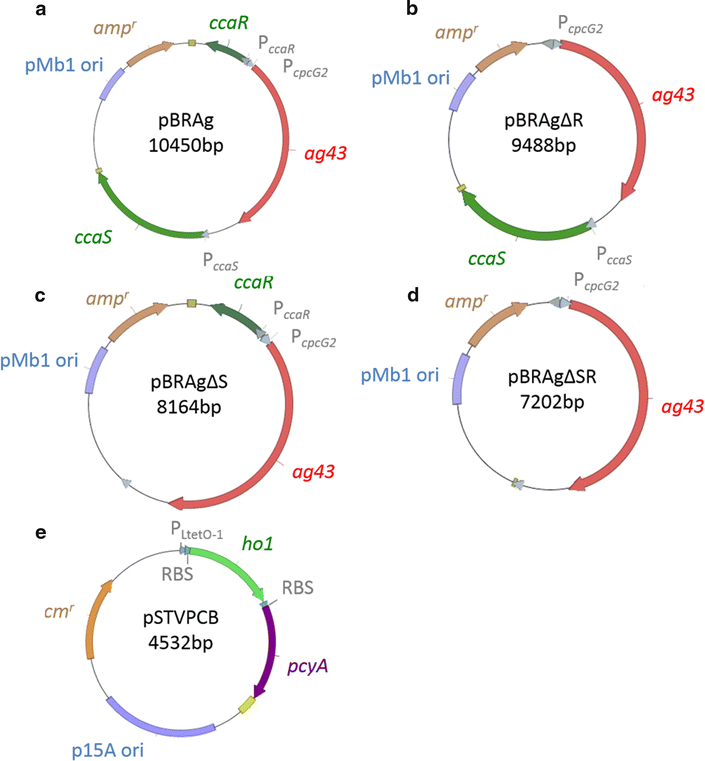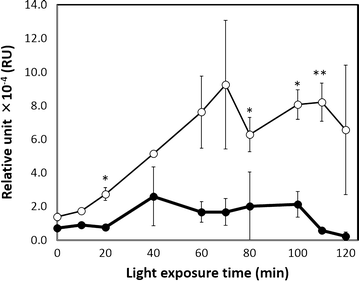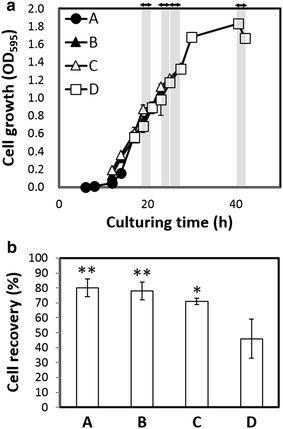Development of a light-regulated cell-recovery system for non-photosynthetic bacteria
- PMID: 26875863
- PMCID: PMC4753666
- DOI: 10.1186/s12934-016-0426-6
Development of a light-regulated cell-recovery system for non-photosynthetic bacteria
Abstract
Background: Recent advances in the understanding of photosensing in biological systems have enabled the use of photoreceptors as novel genetic tools. Exploiting various photoreceptors that cyanobacteria possess, a green light-inducible gene expression system was previously developed for the regulation of gene expression in cyanobacteria. However, the applications of cyanobacterial photoreceptors are not limited to these bacteria but are also available for non-photosynthetic microorganisms by the coexpression of a cyanobacterial chromophore with a cyanobacteria-derived photosensing system. An Escherichia coli-derived self-aggregation system based on Antigen 43 (Ag43) has been shown to induce cell self-aggregation of various bacteria by exogenous introduction of the Ag43 gene.
Results: An E. coli transformant harboring a plasmid encoding the Ag43 structural gene under a green light-regulated gene expression system derived from the cyanobacterium Synechocystis sp. PCC6803 was constructed. Ag43 was inserted downstream of the cpcG 2 promoter P cpcG2 , and its expression was regulated by green light induction, which was achieved by the functional expression of cyanobacterial CcaS/CcaR by coexpressing its chromophore synthesis gene cassette in E. coli. E. coli transformants harboring this designed system self-aggregated under green light exposure and precipitated, whereas transformants lacking the green light induction system did not. The green light induction system effectively functioned before the cell culture entered the stationary growth phase, and approximately 80 % of the cell culture was recovered by simple decantation.
Conclusion: This study demonstrated the construction of a cell recovery system for non-photosynthetic microorganisms induced by exposure of cells to green light. The system was regulated by a two-component regulatory system from cyanobacteria, and cell precipitation was mediated by an autotransporter protein, Ag43. Although further strict control and an increase of cell recovery efficiency are necessary, the system represents a novel tool for future bioprocessing with reduced energy and labor required for cell recovery.
Figures




Similar articles
-
A Green Light-Regulated T7 RNA Polymerase Gene Expression System for Cyanobacteria.Mar Biotechnol (NY). 2021 Feb;23(1):31-38. doi: 10.1007/s10126-020-09997-w. Epub 2020 Sep 26. Mar Biotechnol (NY). 2021. PMID: 32979137
-
Artificial complementary chromatic acclimation gene expression system in Escherichia coli.Microb Cell Fact. 2021 Jul 5;20(1):128. doi: 10.1186/s12934-021-01621-3. Microb Cell Fact. 2021. PMID: 34225717 Free PMC article.
-
The development and characterization of an exogenous green-light-regulated gene expression system in marine cyanobacteria.Mar Biotechnol (NY). 2015 Jun;17(3):245-51. doi: 10.1007/s10126-015-9616-1. Epub 2015 Feb 1. Mar Biotechnol (NY). 2015. PMID: 25638493
-
Regulatory system for light-responsive gene expression in photosynthesizing bacteria: cis-elements and trans-acting factors in transcription and post-transcription.Biosci Biotechnol Biochem. 2006 Mar;70(3):565-73. doi: 10.1271/bbb.70.565. Biosci Biotechnol Biochem. 2006. PMID: 16556970 Review.
-
Synechocystis: Not Just a Plug-Bug for CO2, but a Green E. coli.Front Bioeng Biotechnol. 2014 Sep 18;2:36. doi: 10.3389/fbioe.2014.00036. eCollection 2014. Front Bioeng Biotechnol. 2014. PMID: 25279375 Free PMC article. Review.
Cited by
-
Photoautotrophic production of polyhydroxyalkanoates in a synthetic mixed culture of Synechococcus elongatus cscB and Pseudomonas putida cscAB.Biotechnol Biofuels. 2017 Jul 19;10:190. doi: 10.1186/s13068-017-0875-0. eCollection 2017. Biotechnol Biofuels. 2017. PMID: 28814973 Free PMC article.
-
Construction of a Miniaturized Chromatic Acclimation Sensor from Cyanobacteria with Reversed Response to a Light Signal.Sci Rep. 2016 Nov 24;6:37595. doi: 10.1038/srep37595. Sci Rep. 2016. PMID: 27883080 Free PMC article.
-
Optogenetics in bacteria - applications and opportunities.FEMS Microbiol Rev. 2022 Mar 3;46(2):fuab055. doi: 10.1093/femsre/fuab055. FEMS Microbiol Rev. 2022. PMID: 34791201 Free PMC article. Review.
-
Bacterial Phytochromes, Cyanobacteriochromes and Allophycocyanins as a Source of Near-Infrared Fluorescent Probes.Int J Mol Sci. 2017 Aug 3;18(8):1691. doi: 10.3390/ijms18081691. Int J Mol Sci. 2017. PMID: 28771184 Free PMC article. Review.
-
Cyanobacteriochromes: A Rainbow of Photoreceptors.Annu Rev Microbiol. 2024 Nov;78(1):61-81. doi: 10.1146/annurev-micro-041522-094613. Epub 2024 Nov 7. Annu Rev Microbiol. 2024. PMID: 38848579 Free PMC article. Review.
References
Publication types
MeSH terms
LinkOut - more resources
Full Text Sources
Other Literature Sources

